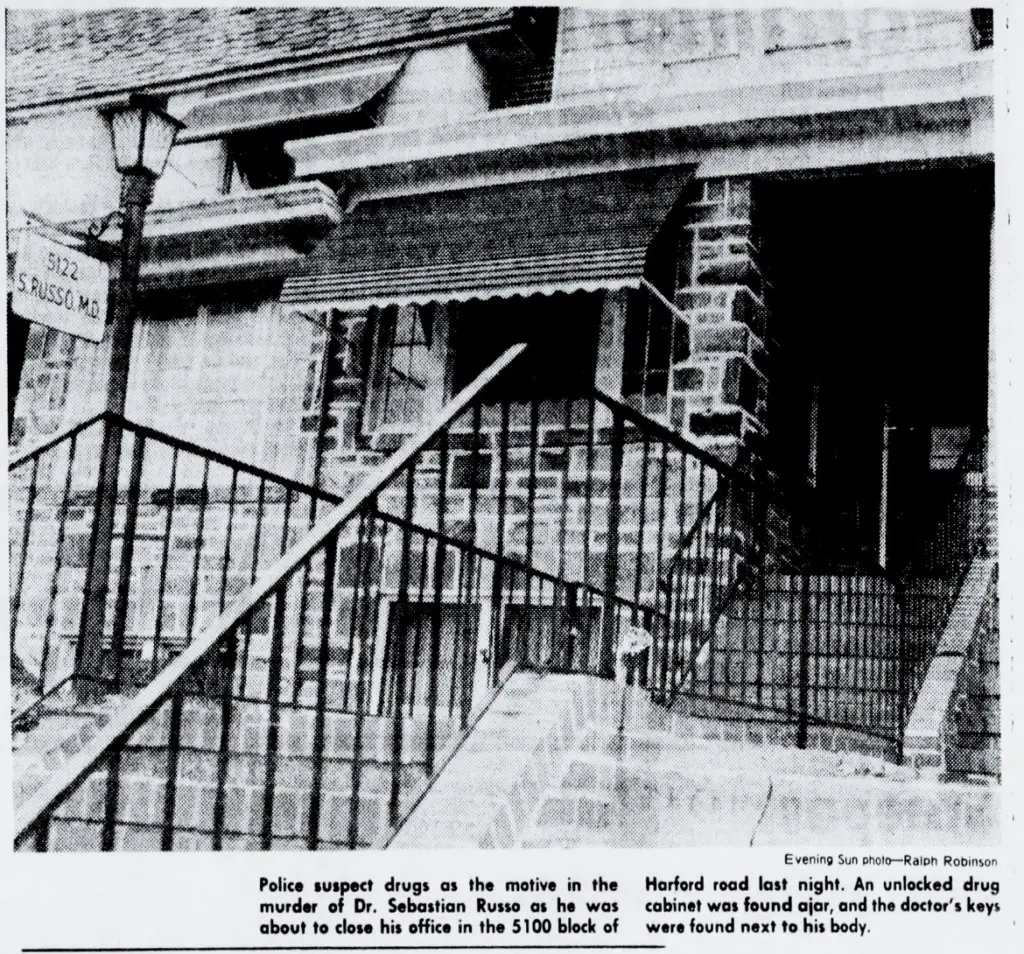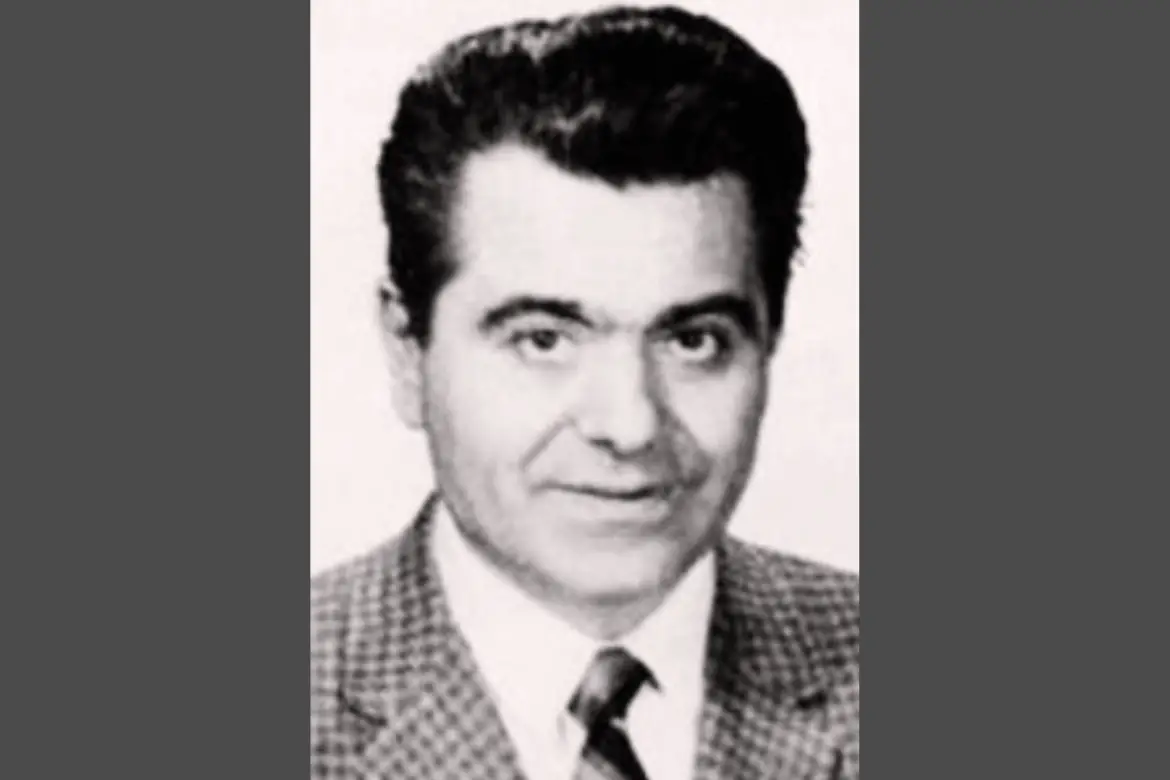Dr. Sebastian Russo was a beloved physician and considered the last of Maryland’s ‘five-dollar docs.’ On February 27, 1981, a still-unidentified man entered Dr. Russo’s Baltimore medical practice and shot him to death, devastating an entire city and leaving his family and patients angry, confused, and in mourning.
One month before John Hinckley, Jr. attempted to assassinate President Ronald Reagan on March 30, 1981, in Washington D.C., police in nearby Baltimore, Maryland, were on edge over a series of violent, deadly burglaries in the area in the previous months.
Between February and April 1981, five people were killed in their homes during burglary or robbery attempts, the Evening Sun reported. In 1980, burglaries increased by 14 percent and robberies by 20 percent. (Hall, 1981) But thieves were becoming murderers to get what they wanted and in attempts to get away with their crimes by eliminating the victims.
But it was the senseless murder of a beloved doctor that shook the city to its core.
‘Five-dollar Doc’
Dr. Sebastian Russo, 57, was Maryland’s last of the ‘five-dollar docs’ and was well-loved by family, friends, and his patients. He and his wife, Mary, lived on Harford Road in Baltimore. Across the street at 5122 Harford Road was Dr. Russo’s medical practice, where his wife worked as his bookkeeper.
Dr. Russo was a kind man who loved being a physician and took great care of his patients. He charged only $3-$5 per office visit, but the visit was free if they had no money. He did not have a secretary or nurse; he handled the paperwork himself.
Dr. Russo would open his practice seven days a week at 7 a.m., go home at noon for lunch, and then spend the afternoon visiting his patients in hospitals. He’d grab a bite for dinner and head back to the office, where he saw patients from 5 p.m. until 11 p.m.
His patients loved him, and everyone spoke kindly about Dr. Russo. He did not have a mean bone in his body and adored his family and patients. Dr. Russo had no known enemies, but one cold winter night, a man entered Dr. Russo’s medical practice and committed a selfish act of violence.
The Murder of Dr. Sebastian Russo

On February 27, 1981, a female patient at Dr. Russo’s practice left at 9:30 p.m. She later told the police that a man had entered the office, ran out a few minutes later, and returned inside.
At 9:35 p.m., a next-door neighbor heard scuffling noises from Dr. Russo’s building and what sounded like someone moaning. Worried, she tried calling Dr. Russo several times, but the line was always busy. She then called the Baltimore police.
When officers arrived, they found Dr. Russo lying on his back between an examination room and a back room containing medical supplies. He had been shot once in the upper left chest with what police believed was a handgun. (Some reports state Dr. Russo was shot multiple times)
Officers noticed a drug cabinet unlocked and ajar, and the doctor’s keys lay on the floor next to his body. (Hill, 1981)
Investigators suspected the killer was looking for drugs. However, Dr. Russo never kept any narcotic drugs in his office and always tried to persuade his patients to take another medication in its place. He would also send his patients to the cheapest pharmacies and not prescribe diet pills.
The investigation into the doctor’s murder frustrated detectives. There was no physical evidence pointing to the killer or eyewitnesses to the murder.
Some patients told the police that a man came into Dr. Russo’s office, stayed briefly, left, and returned a few minutes later to wait an hour for his turn to see Dr. Russo. The witnesses stated that the man and a woman were still in the office when they left, police said. However, they did not know if the man and woman were together. It is unclear whether this is the same woman who left at 9:30 and the man is the same one she saw or if these were two different people.
A longtime patient of Dr. Russo’s, Margaret Wiskless, told The Baltimore Sun that Dr. Russo told her someone had stolen prescription pads from his office the previous year.
“I told him, ‘Watch who you let in your office,” Wiskless said.
Dr. Russo’s murder devastated his patients, who had a hard time understanding why anyone could harm such a gentle soul.
Detectives attempted to track down all of Dr. Russo’s patients to obtain information that could lead them to the killer. Despite a thorough investigation and numerous interviews, they never found the killer.
Funeral
Over 700 people flooded St. Dominic’s Church to pay their last respects to the beloved doctor.
“If you knew him, you knew the ideal of the medical profession,” Rev. Michael Roach told the mourners.
“His life proclaimed that medicine is a life of healing, loving, and serving, not just a way to make a good living.
“He treated so many … the young and old … street people down on their luck. People who were untouchables in our society.
“There’ll be a special place for him in heaven if there ever was for anyone,” said Father Roach.
Memorial in Dr. Sebastian Russo’s Honor
Over two years after his murder, the city of Baltimore decided to honor Dr. Russo. Officials erected a four-faced wrought iron clock at the corner of Harford and Hamilton Avenue.
“We just feel like this [the clock] is an appropriate remembrance to him because of his timeless dedication to his patients in the Hamilton community,” said Lois Munchel, chairman of Dr. Sebastian Russo Reward Fund Committee.
In 2016, the clock was knocked down after a vehicle ran into it. However, the city had it up and running a few weeks later.
The Dr. Sebastian Russo Memorial Award
To ensure Dr. Russo’s legacy lives on, Baltimore’s Health Department created an award in his honor in June 2007 “to recognize health care providers who have made significant contributions to their fields by providing dedicated and compassionate service to low-income individuals and families.” (The JHU Gazette)
The first recipient of the award was Patricia Letke-Alexander, a physician’s assistant, who operated the Johns Hopkins Bayview Community Care-A-Van, “a 39-foot mobile clinic that has been making rounds in Southeast Baltimore, bringing treatment, prevention and health education to uninsured families and others on the margins since 1999.” (Rodricks, 2007)
Aftermath
After Dr. Russo’s murder, his wife, Mary, sold the medical practice to Dr. Frank Palmisano, then 41, who had been a Baltimore area physician since October 6, 1970. He charged $10, not $5, and not all of Dr. Russo’s patients came to him. He saw 11 patients on his first and eventually had hundreds. Dr. Palmisano retired in 2017 and enjoyed retirement until his death at 82 on June 24, 2023. He is survived by his wife, Linda, and his children.
About Dr. Sebastian Russo
Sebastian Russo was in Italy on November 15, 1924. He grew up in Sicily, Italy, emigrated to the U.S. in the early 1950s, and opened his medical practice. In 1957, he married 25-year-old Mary Barabar Bonanno, and the marriage produced a daughter, Roseann, born in the early 1960s.
Mary grew up in Baltimore’s Little Italy and graduated from St. Leo Parochial School and the Institute of Notre Dame in 1939. She worked as her husband’s bookkeeper. Following her husband’s untimely death, she continued living in the Baltimore area and died in 2002 at age 80.
Interesting fact: While Dr. Russo was the last of the ‘five-dollar docs’ in Marylan, he certainly was not the last one in the country.
Dr. Russell Dohner of Rushville, Illinois, opened his practice in 1955 and charged only $5 to his patients until his retirement in 2013. He died two years later, in 2015, at age 90.
I grew up near Rushville and know some of his surviving family members. Like Dr. Russo, Dr. Dohner charged $5 for an office visit, was well-loved by his patients, made house calls, and saw patients seven days a week. He made national news and was featured on The Today Show and People Magazine. He is deeply missed by the community nearly a decade after his death.
I love Rushville. It’s such a beautiful community with the nicest people. The community suffered a tragedy in March of this year that also made national headlines when a school bus carrying preschool children crossed the center line and crashed head-on into the path of a semi-truck, killing everyone, including the truck driver. It was devastating for the families and the community.
If you have any information regarding Dr. Russo’s murder, you can text 433-902-4824 or email homicidetips@baltimorepolice.org.
TCD’s Thoughts
The following is strictly the opinion of this author.
Between February 10, 1981, and Dr. Russo’s murder, three other people were killed in home invasions where robbery was the motive. One of the suspects was a woman. A week after Dr. Russo’s homicide, a homeowner shot and killed a burglar in his home after the assailant attacked him with a crowbar. On March 12, 1981, three masked men rang the doorbell of Reginald McNeal, 71, and forced their way inside when McNeal opened the front door. The intruders demanded money and shot him in the throat, killing him when he said he did not have any.
Whether the investigators thought any of these were connected to Dr. Russo’s murder is unknown. However, it’s possible his killer committed other crimes before and after his death.
What I want to know is whether the female patient who saw the man enter the practice as she left that night ever worked with the police to create a composite sketch. I realize it was dark outside, but she had to see what he looked like through the office lights. I did not find anything about a sketch.
The police theory was the killer was looking for drugs and killed Dr. Russo when he did not have any on hand. It makes the most sense because of the open drug cabinet.
The killer timed the murder perfectly. So, I think he was a patient of Dr. Russo who knew there would probably not be many other patients, if any, waiting at 9:30 p.m. I think he ran out and back in because he was nervous or there was an accomplice waiting in a vehicle, like a getaway driver.
Sources
Bedner, Adam. “Popular Hamilton neighborhood monument damaged.” The Daily Record, May 17, 2016. https://thedailyrecord.com/2016/05/17/popular-hamilton-neighborhood-monument-damaged/
Hall, Wiley. “Burglards becoming deadlier, police find.” The Evening Sun, April 2, 1981.
Hill, Gwen. “Hamitlon doctor slain in his office.” The Evening Sun (Baltimore, Maryland), February 28, 1981.
“Physician/community advocate receives prestigious city award: Gazette Archives.” The JHU Gazette, September 27, 2010. https://gazette.jhu.edu/2010/09/07/physiciancommunity-advocate-receives-prestigious-city-award/
LoLordo, Ann. “Memorial to murdered doctor is planned.” The Baltimore Sun, June 16, 1983.
“Police seek patients of slain doctor.” The Evening Sun, March 2, 1981.
Taub, K. Deborah. “Slain doctor is called ‘last of humanitarians.'” The Baltimore Sun, March 1, 1981.
Wooton, Suzanne. “Hundreds came to honor slain physician.” The Evening Sun, March 3, 1981.



